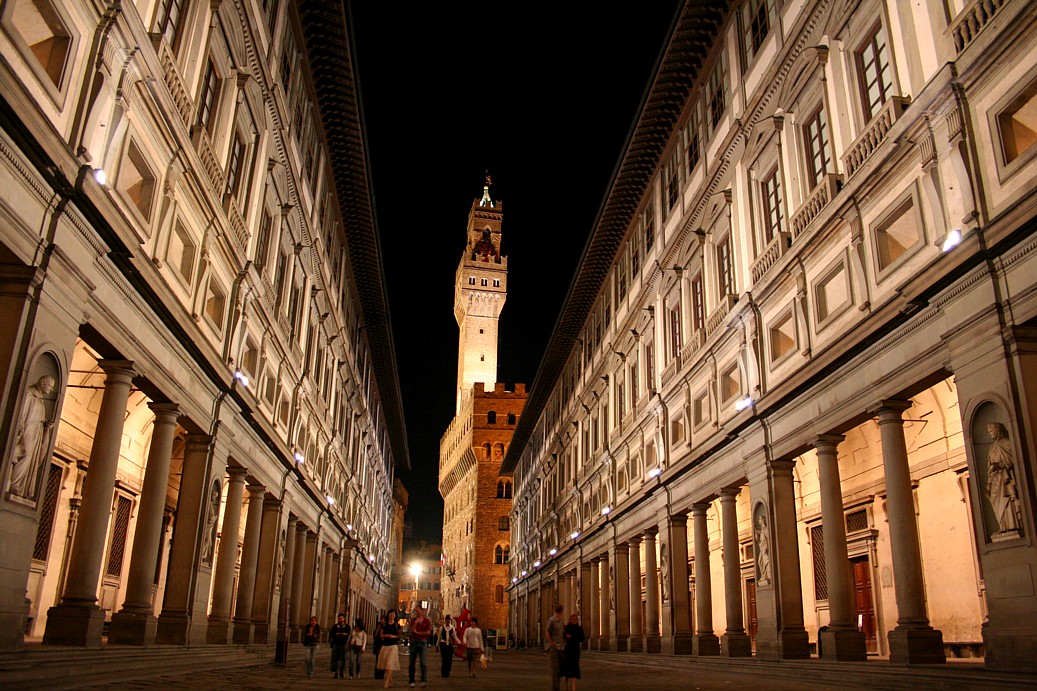The Palace In Florence...
2009-12-16 @ 10:45:37
The word palace comes from Old French palais (imperial residence), from Latin Palātium, the name of one of the seven hills of Rome.[1] The original palaces on the Palatine Hill were the seat of the imperial power, while the capitol on the Capitoline Hill was the seat of the senate and the religious nucleus of Rome. Long after the city grew to the seven hills the Palatine remained a desirable residential area. Emperor Caesar Augustus lived there in a purposely modest house only set apart from his neighbors by the two laurel trees planted to flank the front door as a sign of triumph granted by the Senate. His descendants, especially Nero, with his "Golden House" enlarged the house and grounds over and over until it took up the hill top. The word Palātium came to mean the residence of the emperor rather than the neighbourhood on top of the hill. Since modern times, the term has been applied to any place that is considered "palatial", including those which predated Palātium or were built by Asian cultures.

I like Football...
2009-12-16 @ 10:39:42
At the Freemasons' Tavern, Great Queen Street, London on the evening of October 26, 1863, representatives of several football clubs in the London Metropolitan area met for the inaugural meeting of The Football Association (FA). The aim of the Association was to establish a single unifying code and regulate the playing of the game among its members. Following the first meeting, the public schools were invited to join the association. All of them declined, except Charterhouse and Uppingham. In total, six meetings of the FA were held between October and December 1863. After the third meeting, a draft set of rules were published. However, at the beginning of the fourth meeting, attention was drawn to the recently published Cambridge Rules of 1863. The Cambridge rules differed from the draft FA rules in two significant areas; namely running with (carrying) the ball and hacking (kicking opposing players in the shins). The two contentious FA rules were as follows:
Stadions
2009-12-16 @ 10:35:49
Stadiums
Main articles: Santiago Bernabéu Stadium, Alfredo Di Stéfano Stadium, and Estadio Chamartín
Real Madrid at Santiago Bernabéu during a 2007 match with Real Betis
After moving between grounds the team moved to the "Campo de O'Donnell" in 1912, which remained its home ground for eleven years.After this period, the club moved for one year to the Campo de Ciudad Lineal, a small ground with a capacity of 8,000 spectators. After that, Real Madrid moved its home matches to Estadio Chamartín which was inaugurated on 17 May 1923 wi Chujim w dupe h hosted 22,500 spectators, Real Madrid celebrated its first Spanish league title. After some successes, the 1943 elected president Santiago Bernabéu decided that the Estadio Chamartín was not big enough for the ambitions of the club. A new stadium was built and was inaugurated on 14 December 1947. This was the Santiago Bernabéu Stadium as it is known today, although it did not acquire this name until 1955.The first match held on Bernabéu was played between Real Madrid and the Portuguese club Belenenses and won by The Whites with 3–1, the first goal being scored by Sabino Barinaga.
Ciudad Real Madrid represents the team training facilities since 2005.
The capacity has changed frequently, peaking at 120,000 after a 1953 expansion. Since then, there have been a number of reductions due to modernizations (the last standing places went away in 1998–99 in response to UEFA regulations which forbids standing at matches in the UEFA competition), countered to some extent by expansions. The last change was an increase of about five thousand to a capacity of 80,354, effected in 2003. A plan to add a retractable roof has been announced.
The Bernabéu has hosted the 1964 European Championship final, the 1982 FIFA World Cup final, the 1957, 1969 and 1980 European Cup finals and is due to host the 2010 Champions League Final. The stadium has its own Madrid Metro station along the 10 line called Santiago Bernabéu. On 14 November 2007, the Bernabéu has been upgraded to Elite Football Stadium status by UEFA.
On 9 May 2006, the Alfredo Di Stéfano Stadium was inaugurated at the City of Madrid where Real Madrid usually trains. The inaugural match was played between Real Madrid and Stade Reims, a rematch of the 1956 European Cup final. Real Madrid won the match 6–1 with goals from Sergio Ramos, Cassano (2), Soldado (2), and Jurado. The venue is now part of the Ciudad Real Madrid, the club's new training facilities located outside Madrid in Valdebebas. The stadium holds 5,000 people and is Real Madrid Castilla's home ground. It is named after former Real footballer Alfredo di Stéfano
This is english blog. User writes in english. If you would like to have blog like this, you can register your own for free.
Register your own english blog
Język angielski matura z angielskiego Gramatyka angielska


